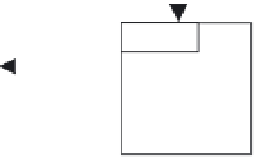Environmental Engineering Reference
In-Depth Information
150
egestion + death
0.2
FISH
0.01
0.5
predation
fisheries
15
egestion + death
outflow
ZOOPLANKTON
0.4
0.4
0.9
2.0
excretion
1.2
3.0
grazing
grazing
95
60
1.1
1.9
PHYTO-
PLANKTON
DETRITUS
excretion
mineral.
1.5
4.5
0.2
1.1
9
10
SRP
ads.P
uptake
sorption
inflow
1.0
0.4
4.5
0.1
3.2
phosphorus fluxes
(mg of P m
-2
day
-1
)
2.9
50
sorption
excretion
90
300
ads.P
1.1
SRP
< 0.2
0.2 - 0.5
0.5 - 1.25
1.25 - 3.0
3.0 - 8.0
> 8.0
1.0
2.0
SEDIMENT
mineral.
20
feeding
BENTHOS
2.0
0.2
egestion + death
0.6
seepage
Fig. 12.9
Simulated P-flow scheme of Lake Loosdrecht through different trophic levels, water and sediment
(boxes), based on the summer averages of concentrations (mg of P m
−2
) and flows (mg of P m
−2
day
−1
) during 1987.
Because fish comprise an important P stockpile, they apparently contribute to P continuously to the P input of
the soluble reactive phosphorus (SRP) pool, which is very small but very dynamic and with a very high turnover.
ads.P, adsorbed P; infiltr., infiltration; mineral., mineralization. From Janse
et al.
(1992). With kind permission of
Springer Science and Business Media.
arbitrary considering the enormous variations of fish
stocks in lakes that need to be reduced to < 50 kg
ha
−1
to produce effects. Moreover, continual fish
management appears to be indispensable to pro-
duce sustained, positive effects on water quality, but
this strategy may not be a realistic one considering
the cost-benefit aspect. About an 80% reduction in the
fish standing stock was needed to achieve a standing
crop of
c
.20 kg of fresh weight ha
−1
in many Dutch
lakes, during a 5-year period of fisheries manage-
ment (Lammens
et al.
2002). Such fish reductions in
shallower lakes stimulated the
Chara
beds to expand
(Hosper 1997) as well as zebra mussel populations
to increase. Consequently the light climate in open
water improved distinctly. In Frisian Lakes, however,
good recruitment and higher growth rates of bream
generally nullified the effects of management measures
so that improvements in the light climate were only
marginal.
Planktivorous fish generally play a crucial role in
P recycling, especially in shallow lakes, and retard the
pace of restoration. Because of their high P content
per unit body weight and their very high standing crop
the planktivores comprise a major P store and con-
tribute to a lake's continuous and steady P regenera-
tion via egestion, mortality and metabolic excretion
(Fig. 12.9; Janse
et al.
1992, see also a review by
Lazzaro 1987). Van Liere and Janse (1992) estimated
that in Loosdrecht Lakes the P regenerated from fish
(excretion, egestion and death) was about 140% of the
external loading. Nutrients and algal concentrations
are expected to decline upon removal of planktivores





















































































